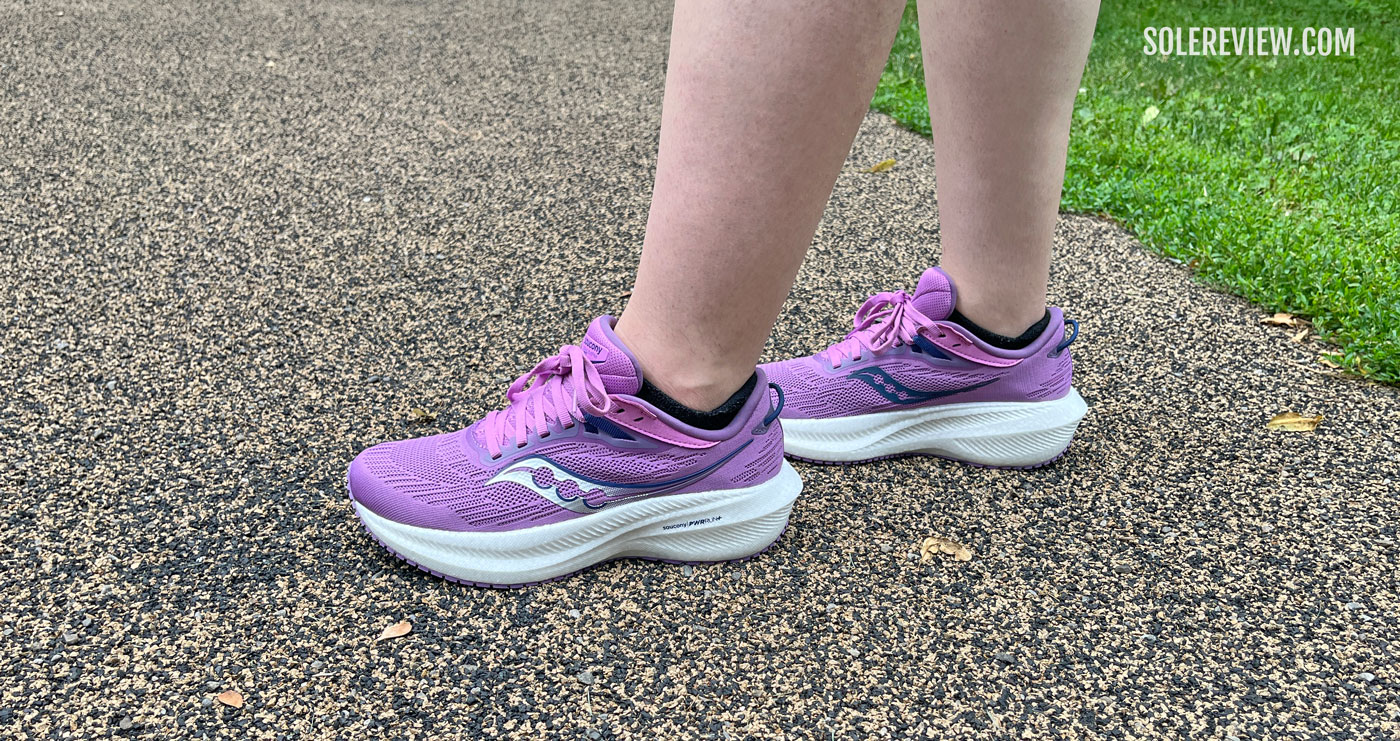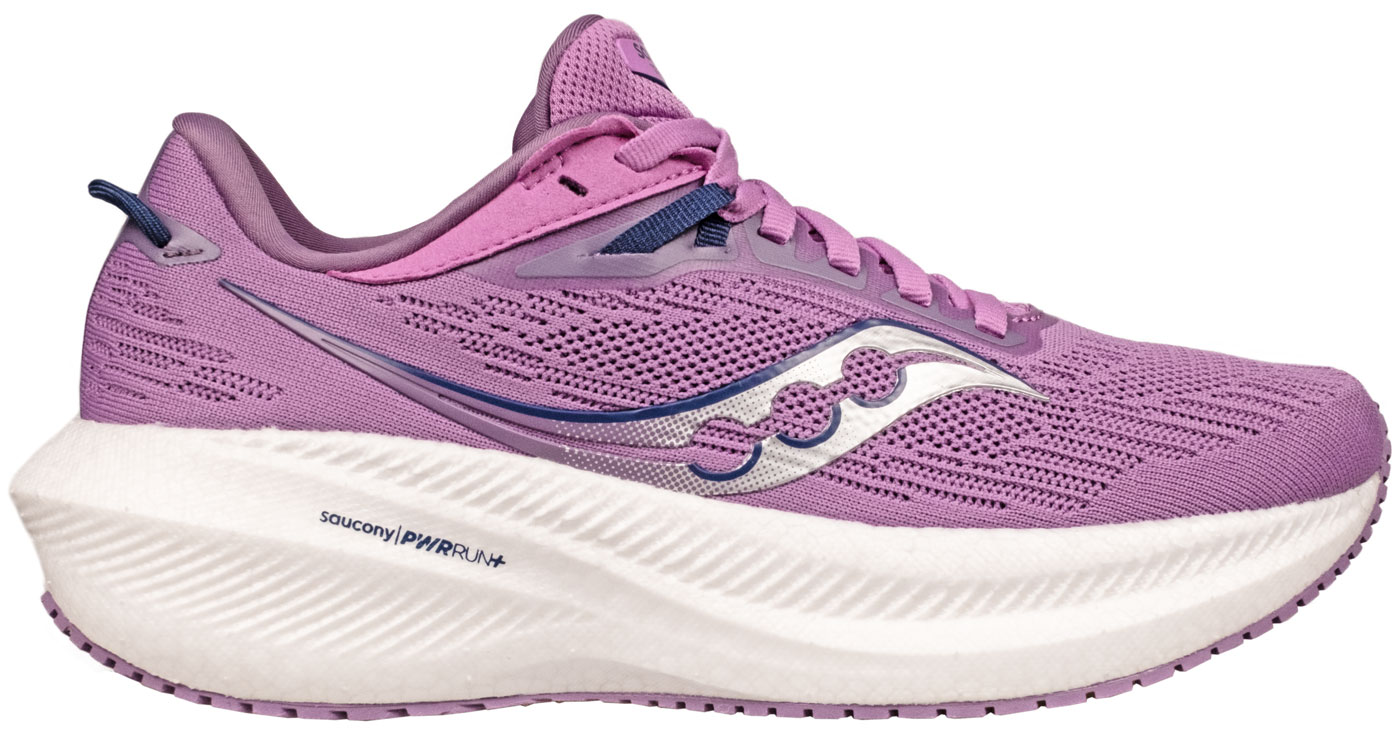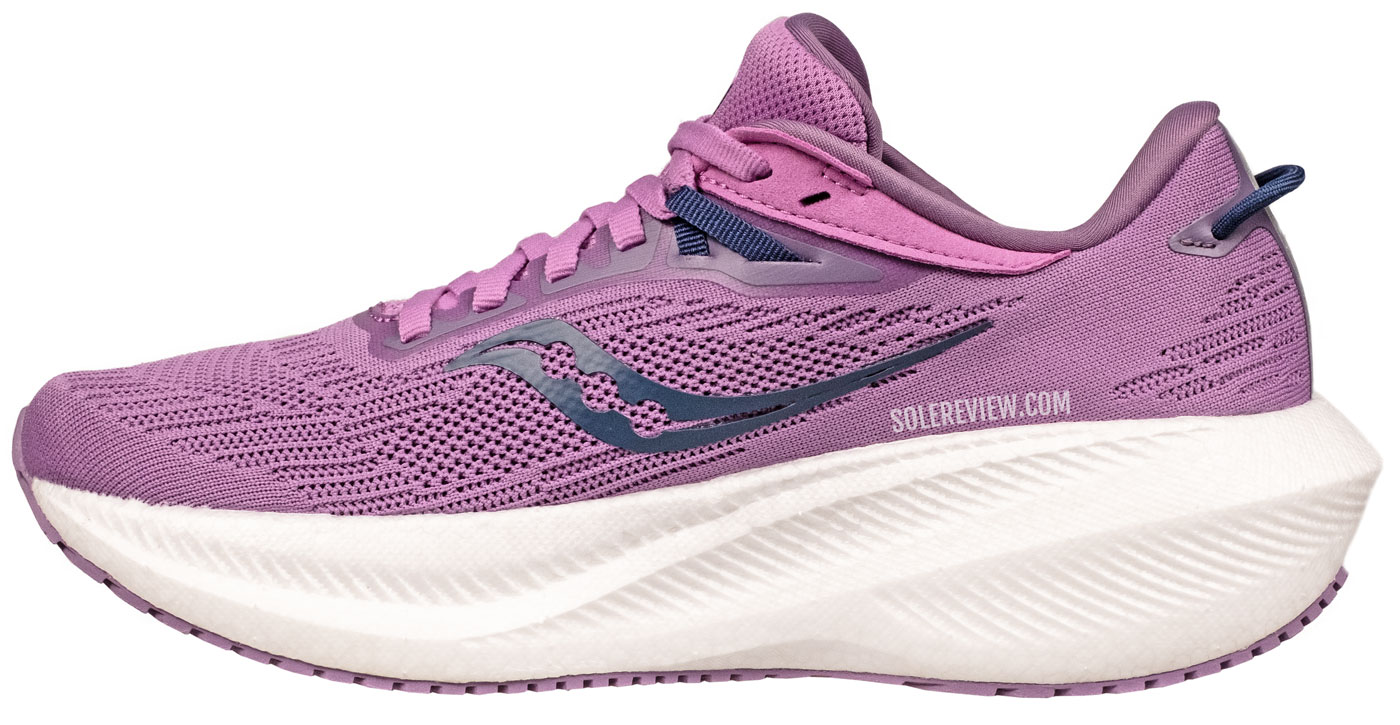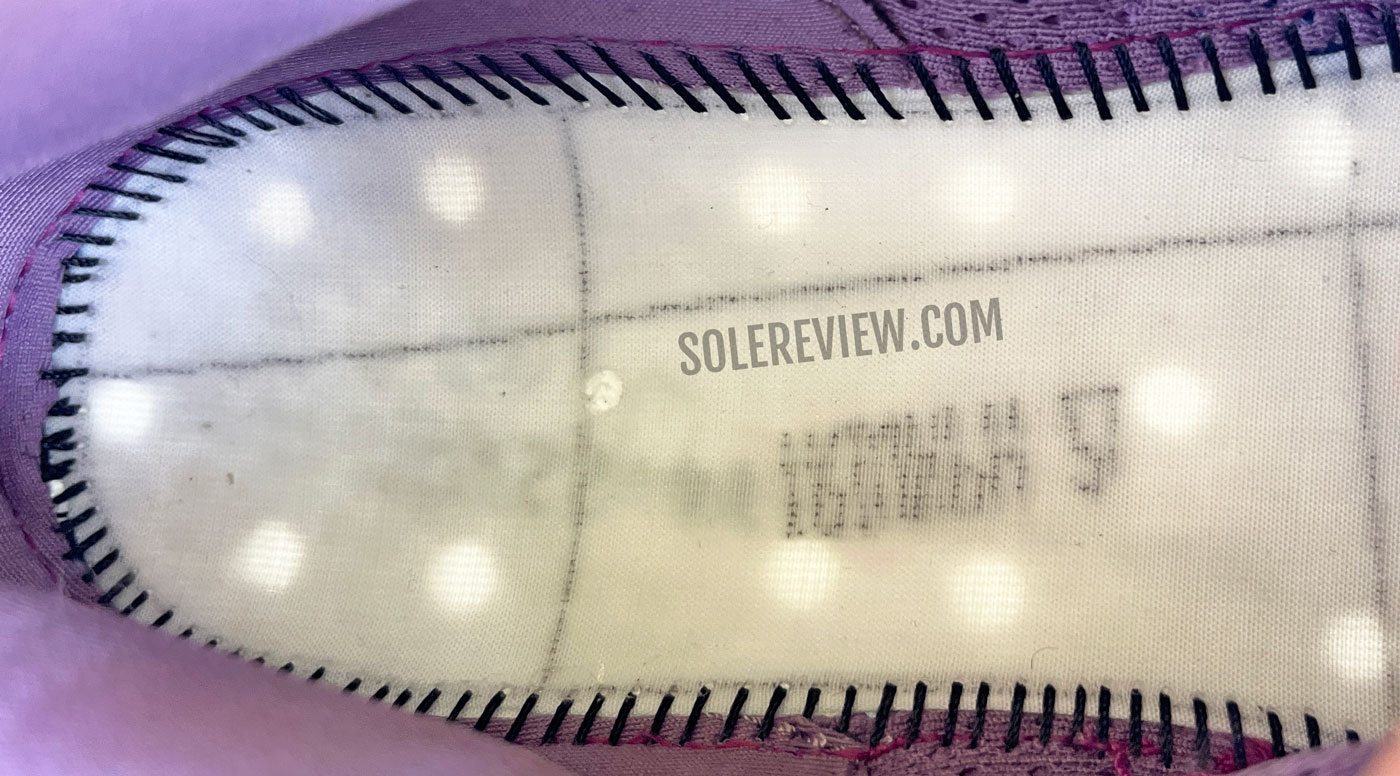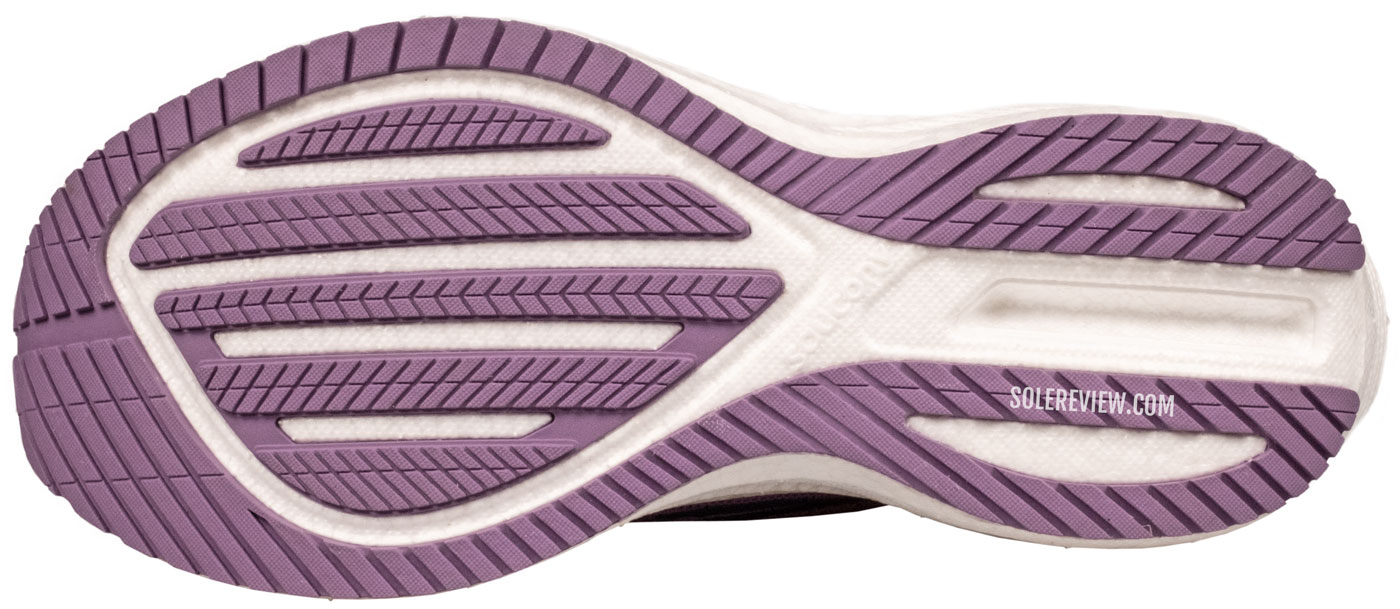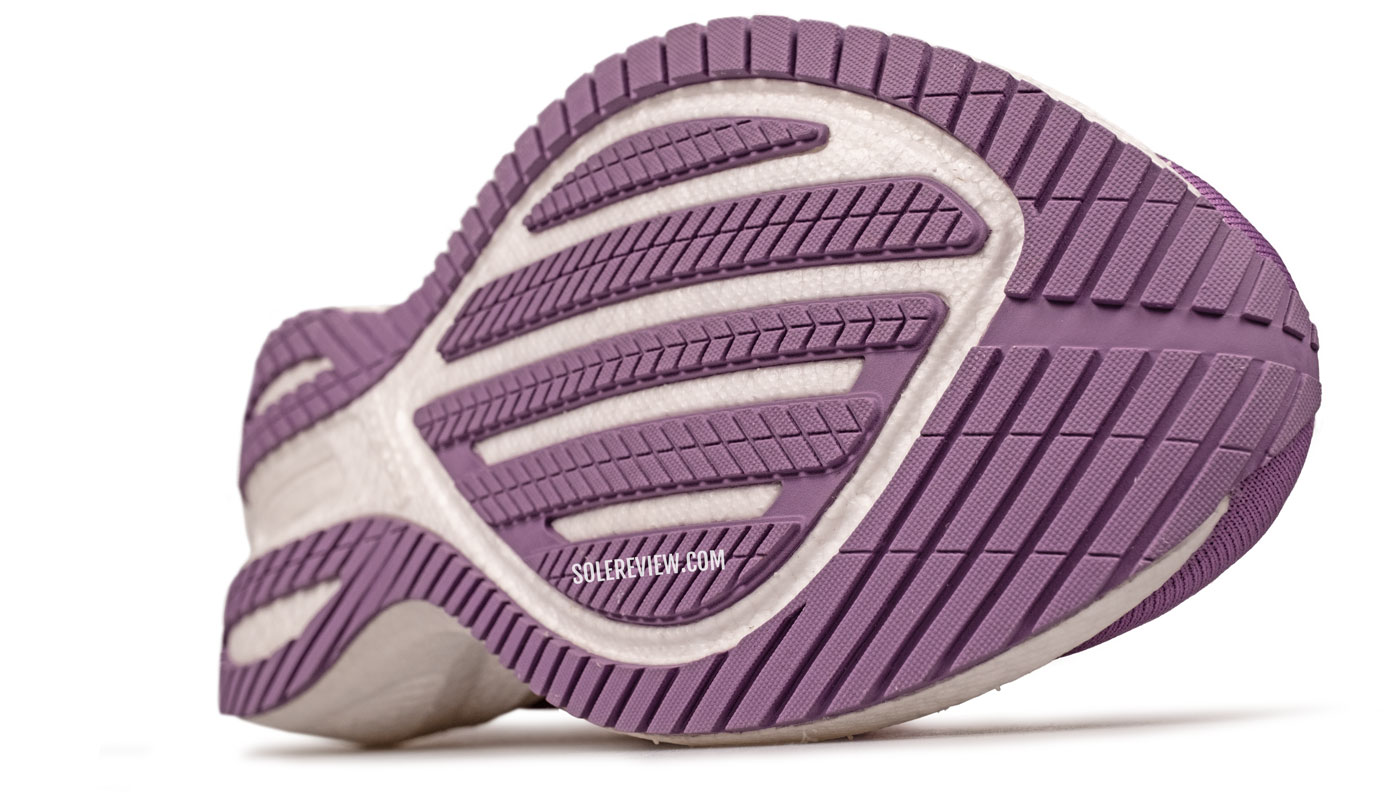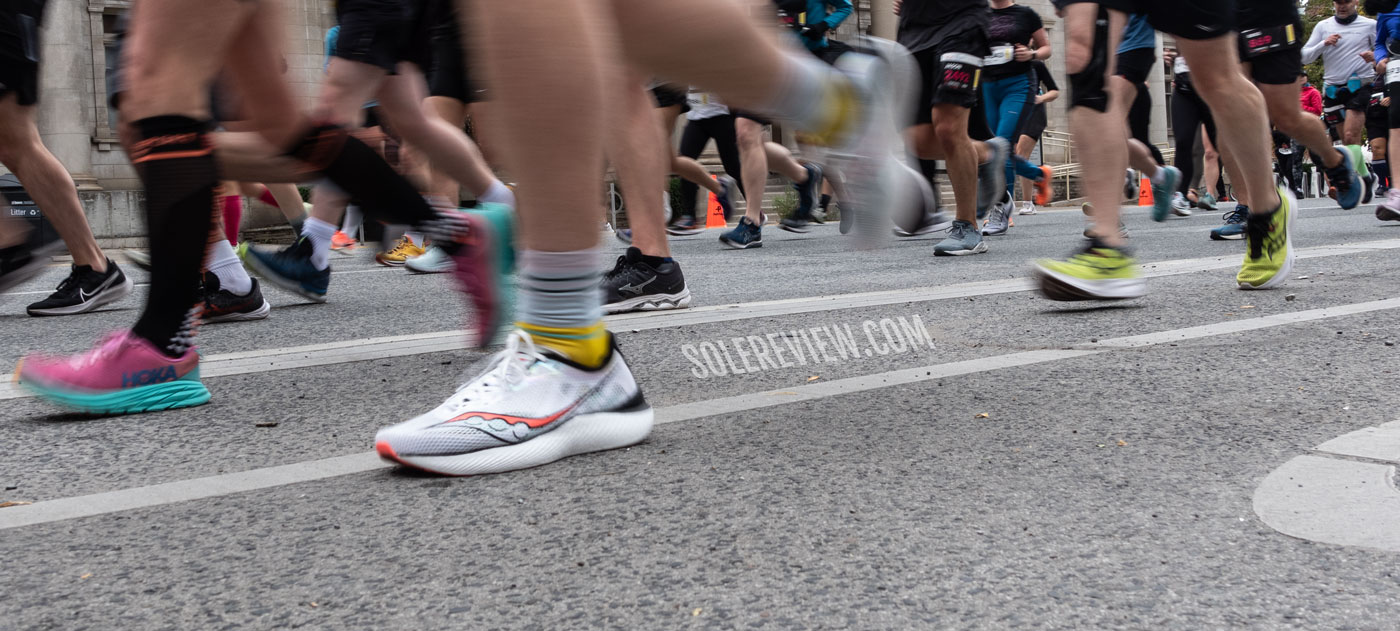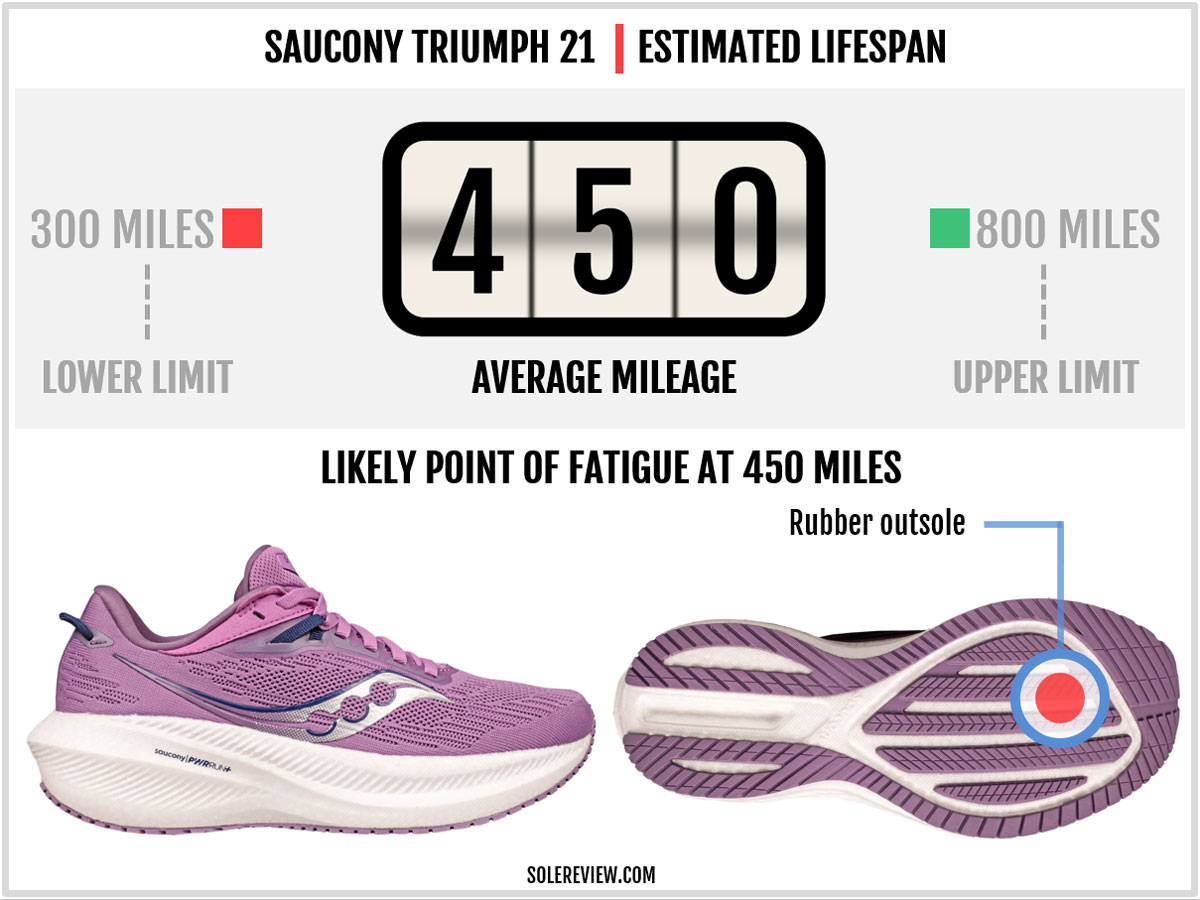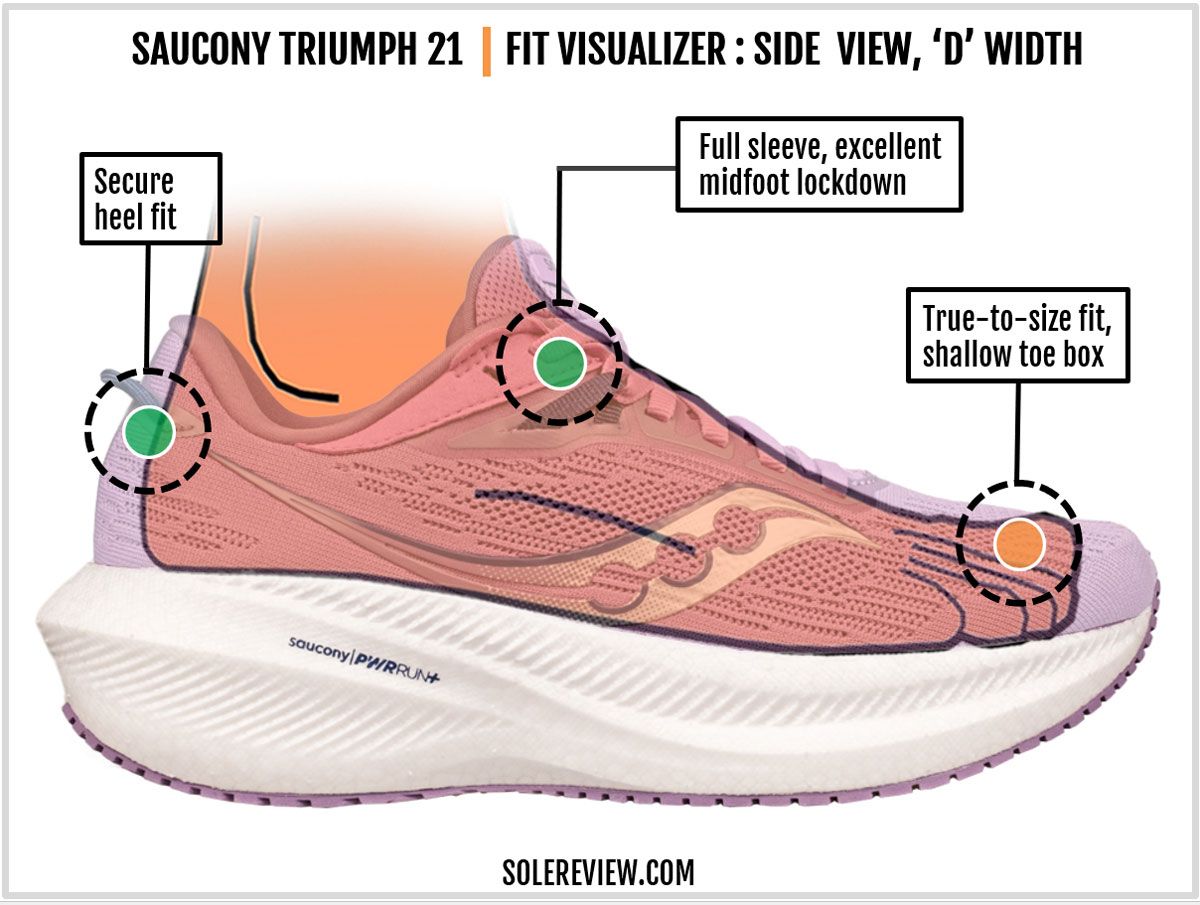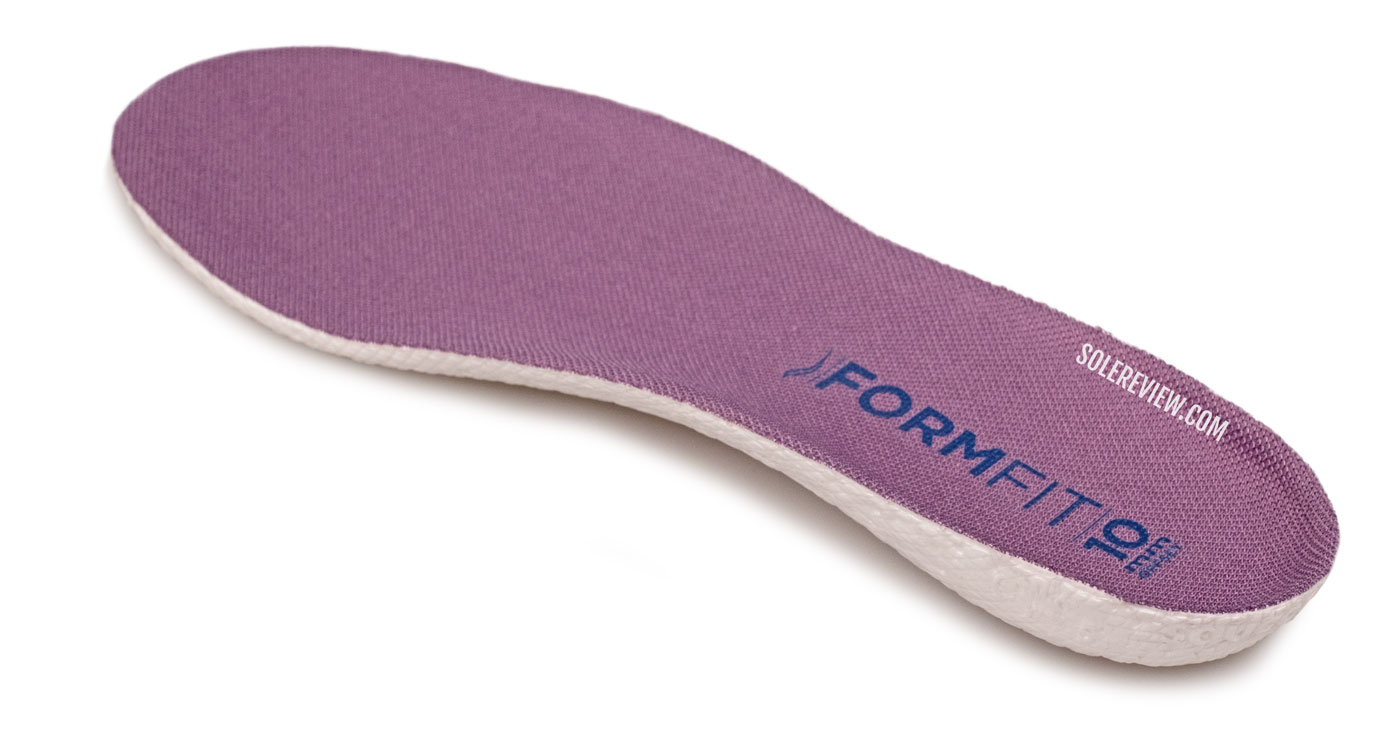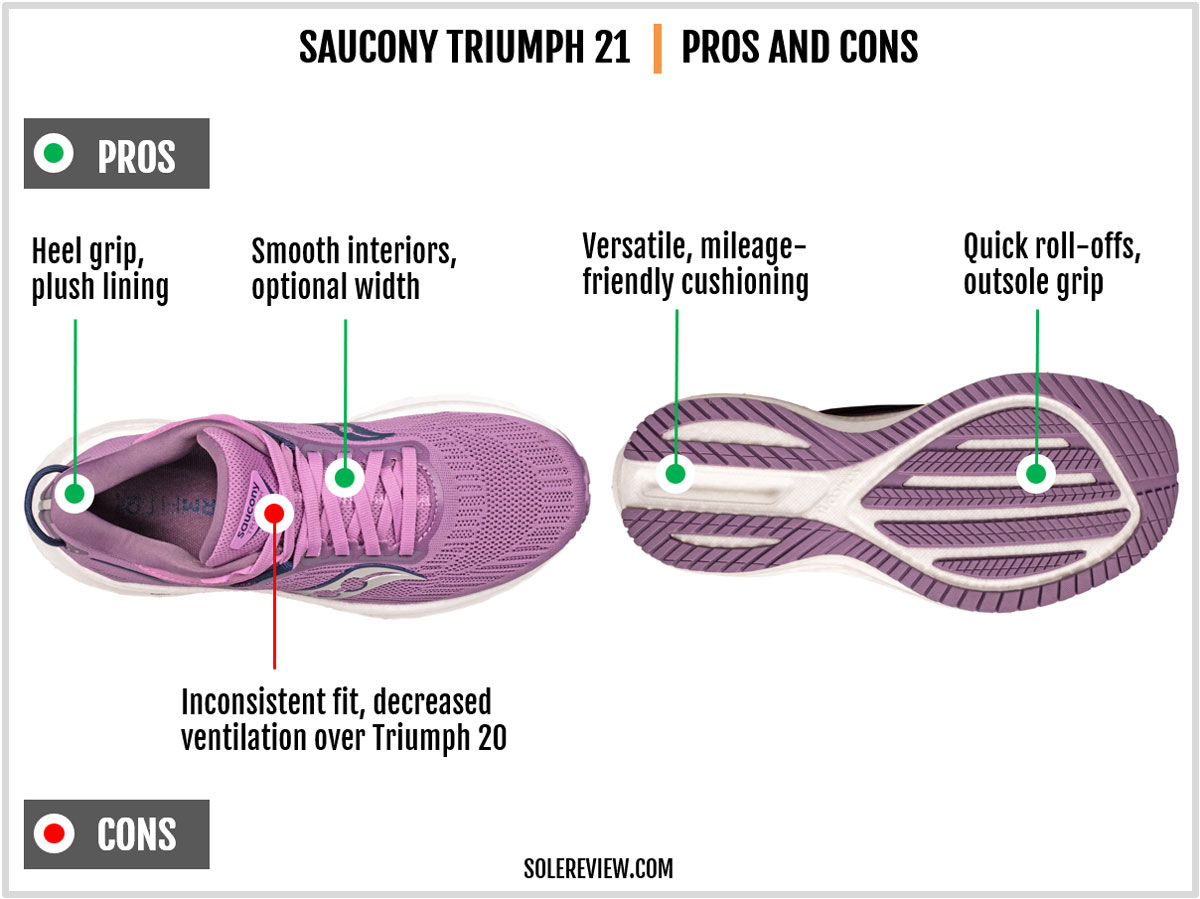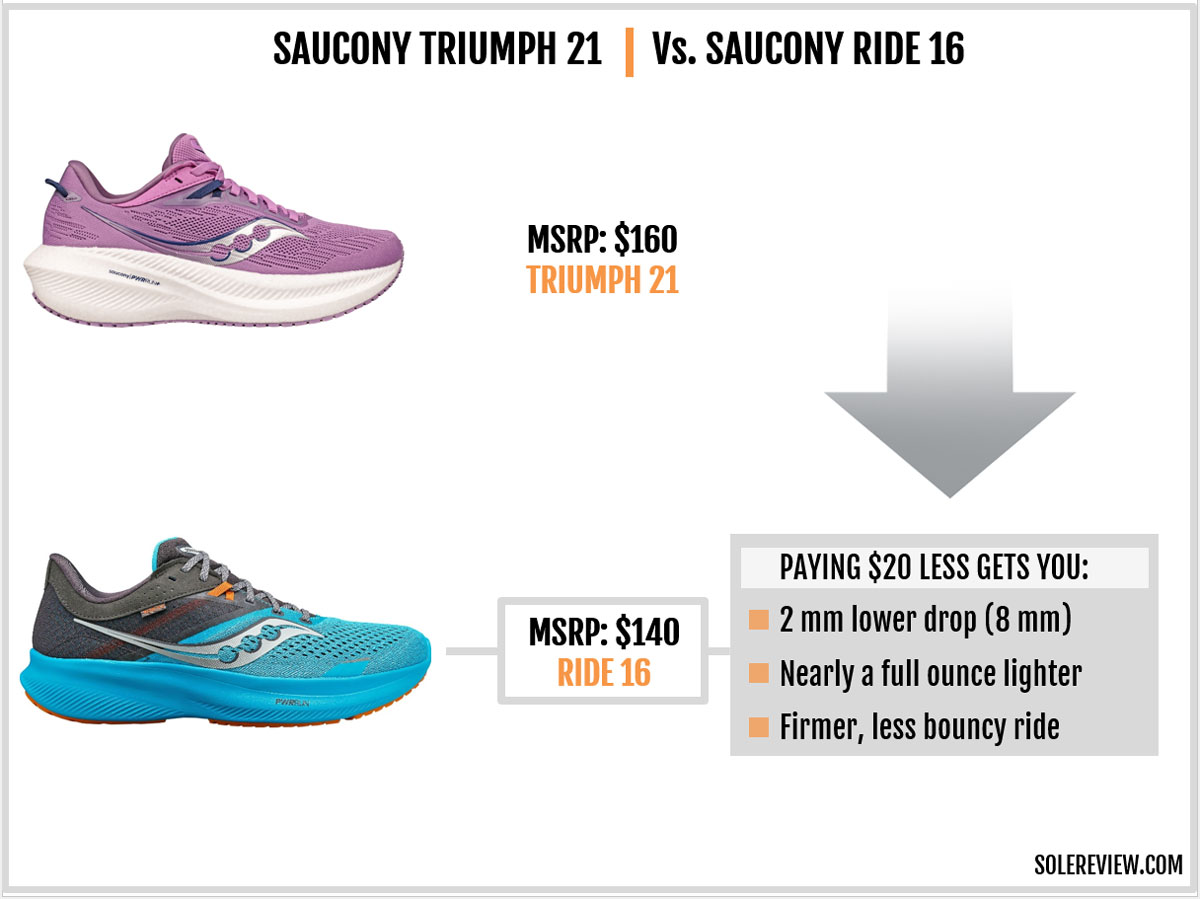
For this review, Solereview paid the full retail price for the Saucony Triumph 21. The amount is in Canadian Dollars.
In this review:
SUMMARY AND VERDICT
Running shoe updates are full of surprises; one never knows what to expect.
Such is the case with the Saucony Triumph 21. On the surface, this model appears to have received a superficial, upper-only refresh. In reality, the changes are more than just skin deep.
When the updated version of a running shoe uses the same midsole and outsole as the previous one, the most important question is – should you stick to the older model, or upgrade?
The Saucony Triumph 21 has a lot of what made the Saucony Triumph 20 so good, but just know that both are not the same.
So what hasn’t changed? Well, we get the same Pwrrun+ midsole with its deeply cushioned, responsive, and peppy ride. The grippy outsole and Pwrrun+ insole also carry over from the T-20.
In essence, the Saucony Triumph 21’s road manners are nearly identical to the outgoing model. It’s an excellent everyday trainer as well as a running shoe for the occasional marathon. It’s not particularly quick, but it can sustain 4:30 min/km (7:00 min/mile) speeds during a long-distance run.
It’s a well-rounded running shoe that makes the best use of the expanded Polyurethane foam tech that the Saucony Pwrrun+ and adidas Boost are based on.
The Saucony Triumph 21’s upper is a mixed bag. It’s not as spacious as the Triumph 20, and also less breathable. The improved fit security comes at the cost of a tighter, warmer, and shallower fit.
Running shoes tend to be a personal choice, as will the Saucony Triumph 21. If you wished that your Triumph 20 had a more secure fit, then that’s a good reason to get the 21.
And if you were more or less pleased with the Triumph 20, we recommend that you grab another pair of the same and skip the 21.
THE SAUCONY TRIUMPH 21 COMPARED WITH TRIUMPH 20
With an identical midsole and outsole setup, everything’s the same under the foot – almost. The upper, however, is crammed with fit-affecting updates. The most significant tweak of all is the inclusion of a full inner sleeve.
The Triumph 20 only had a partial gusset. But the Saucony Triumph 21 has a complete sleeve that begins where the heel lining ends, and goes all the way to the front.
This effectively makes the Triumph 21’s upper a two-layer kind, as opposed to the single mesh design of the 20.
Saucony has relocated the midfoot strap towards the rear, and this has a positive outcome on the fit. The 20’s straps applied pressure when laced tight, so that ceases to be a problem.
Lastly, the heel collar no longer relies on a two-piece construction as the Triumph 20 did. Its one-piece construction makes the heel fit snugger than the previous version.
If you want to know where all this is leading, here’s the gist. The full sleeve reduces the interior space and makes the shoe less breathable than the Triumph 20. From a sensory perspective, the upper sits closer to the foot, thus improving the fit security.
The midfoot straps get smaller in size and retreat towards the rear where it doesn’t have the same influence as before. In our view, the straps are gratuitous and the shoe can do without them.
The ride quality also undergoes a slight change. The narrower upper ‘contains’ the foot better over the forefoot, so the power transfer is marginally better and focused. Snug uppers tend to do that to the ride experience; racing flats, football boots, and hockey skates are all good examples.
THE MIDSOLE DESIGN AND RIDE EXPERIENCE
We’ll keep it brief. With a minor exception, the ride quality hasn’t evolved since the Triumph 20. The last time, we spent a lot of time breaking down the ride experience; more details are here.
So if all the midsole and outsole components are the same as before, what could have possibly changed? The answer lies in the fully-sleeved upper.
The Saucony Triumph 20 had a very broad toe box that allows the toes to splay wide. That’s no longer true on the Triumph 21. The inner sleeve wraps the forefoot like a ‘bag’, so the foot’s position over the midsole is more ‘fixed’ when compared to the Triumph 20.
When the foot is constrained to a smaller area than before, the power transfer is more focused. Inside the Triumph 21, the ground connection is marginally better than the 20.
While it’s not glaringly obvious, perceptive runners will sense the difference.
Other areas of performance mirror the Triumph 20; after all, the midsole has an identical spec sheet. The midsole is 37 mm thick under the heel and has a 27 mm tall forefoot. So despite its 10 mm drop, both the forefoot and heel are generously padded.
Like the past few Triumphs, the midsole uses Saucony’s Pwrrun+. It’s a type of expanded Polyurethane foam that’s similar to adidas Boost.
A thick Pwrrun+ insole adds more cushioning on top. A thin fabric lasting covers the main midsole – you can also see the hollow sections (created by the mold inside the midsole) that reduce the weight and increase the cushioning softness.
Most runners who have run in a shoe with expanded PU foam (including the Reebok Floatride) will recognize the familiar characteristics. E-TPU foam is durable, resistant to temperatures, somewhat firm, and depending on the density, mildly responsive.
Saucony, in particular, has done a great job of fine-tuning this platform.

Despite its height, the midsole delivers a very neutral ride. It’s adequately supportive, considering how cushioned the shoe is.
The finished product delivers an excellent balance of ride comfort, support, and transition-friendly responsiveness. The shape and stack heights are equally important. The tall midsole offers comfort during long runs, whereas the semi-rocker forefoot helps the foot roll forward.
The foot is seated within the cupped midsole; the raised midsole walls integrate with the internal heel counter (on the upper) to create a cupping effect.
A deep transition groove and heel bevel also help with the overall stability and heel landings. There’s no cushioning bias, so the overall ride comes across as very neutral.
Midfoot striking is completely within the Triumph 21’s comfort zone. The heel crash pad doesn’t overextend, and the beveled edge prevents the heel from catching the ground.
Outsole rubber is used along the important contact areas, so there are no gaps in traction. The rib-like design grips well, and the articulated forefoot outsole blends into the midsole without any stiffness.
RECOMMENDED ROTATION
If your running program covers a wide variety of speeds and distances, then the Triumph 21 rotates best with a low-profile racer and a cushioned marathon racer.
The Saucony Sinister is an ultra-light and tight-fitting racer that puts itself to good use during short-distance (5K) races.
The Endorphin Speed and Pro are excellent marathon racers that combine long-distance comfort with a speed-friendly ride. The Nike Vaporfly 3 (or the Vaporfly 2/adidas Adios Pro 3 for better durability) is also great.
If the Sinister is too narrow for your liking, consider the adidas adios 8. While not as lightweight, it makes up with a more robust build and relatively spacious interiors. The adios 8 has been completely redone with a softer ride and more upper room.
IS THE SAUCONY TRIUMPH 21 DURABLE?
The upper is double-layered this time, so it’s highly unlikely for it to fail prematurely. The Pwrrun+ foam midsole is also highly resistant to cushioning loss, and the articulated outsole flexes with the midsole, thus slowing the wear and tear.
Getting 450-500 miles of running should be easy from the Saucony Triumph 21. Let us know here should your experience with the Triumph 21 (or even the Triumph 20) be any different.
THE UPPER DESIGN AND FIT
Even though the Saucony Triumph 21 now has a full interior sleeve, our recommendation is to buy true to size. We tried a half-size larger (eg: US 11.5 instead of 11) and it was too loose. You just won’t get the relatively accommodating toe-box of the Triumph 20, that’s all.
The redesigned heel, while very secure, doesn’t have the slight play that the 20 had. The new heel collar gets rid of the seam from the last model, so the grip is more aggressive in how it fits.
A heel lock is optional, but we have a feeling most runners will not need it.
So the over-arching theme of the Saucony Triumph 21’s fit is, for lack of a better term, tightness. The upper fit feels a lot more dialed in, be it the double-layered upper or the redesigned heel collar. Let’s be clear – the Triumph 21 doesn’t have Asics Nimbus 25 levels of unbreathable tightness. The fit is similar to the Nike Structure or Nike Pegasus.
Therefore, the better fit security is the only reason why somebody should buy the Triumph 21 – or not. The reverse is also true – get the Triumph 20 for a more relaxed fit.
Just like the last time, Saucony sells an optional wide in this model.
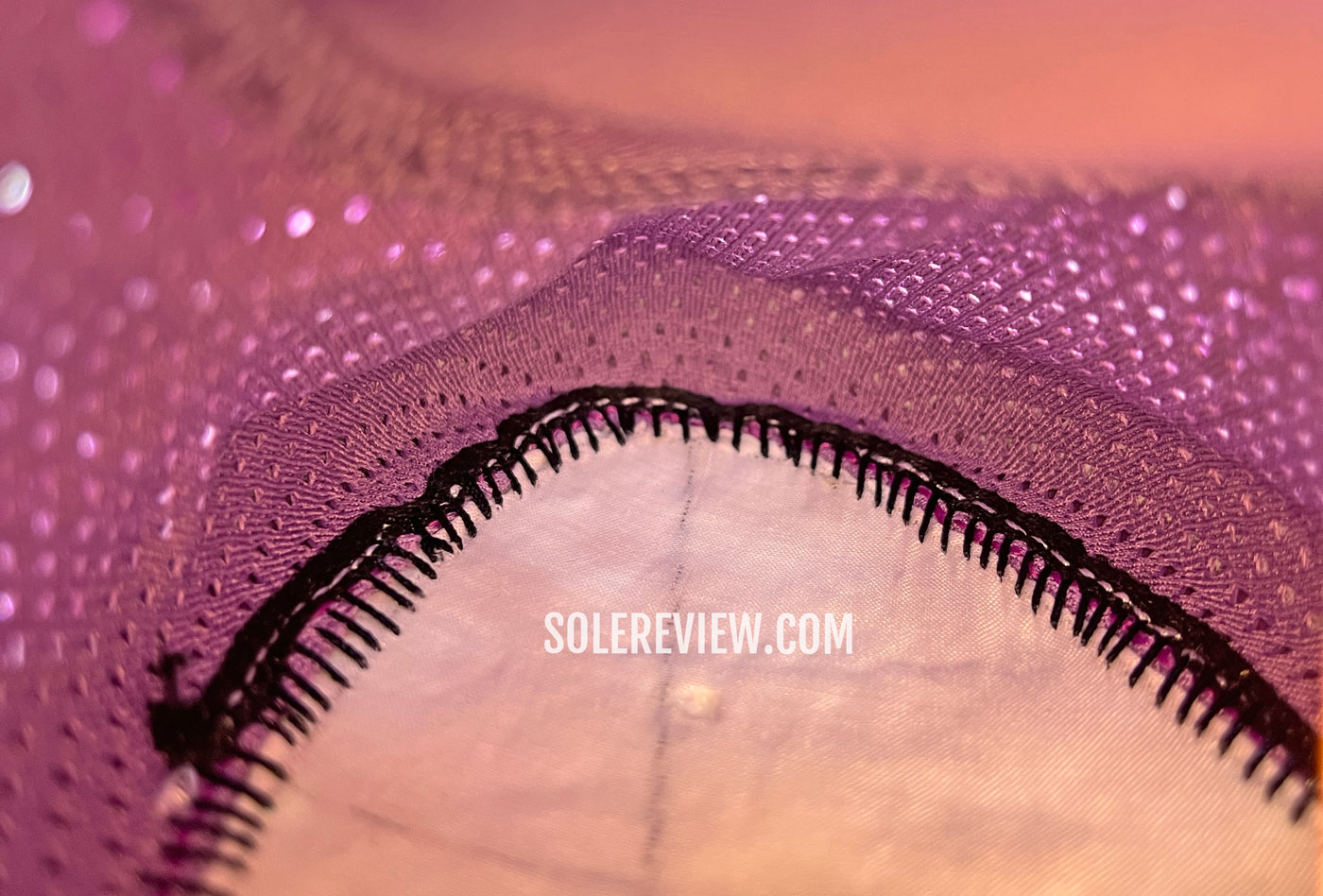
While the shoe isn’t stuffy like the Asics Nimbus, it’s not as free-flowing as the Triumph 20. It’s closer to Nike Pegasus levels of ventilation.
During summer, the ventilation level can make or break a running shoe. From the outside, the mesh appears generously perforated – which it is. However, the sock-like inner sleeve behaves like a secondary upper.
While you won’t be miserable inside the shoe (like the Nimbus 25), the air circulation is a magnitude lower than the 20. Saucony’s 2023 mandate appears to be replacing partial gussets with full sleeves. The Kinvara 14 also received a similar treatment.
The tongue is typical Triumph fare. It’s padded, soft, and effectively filters the lacing cinch from the soft, elastic laces.
The upper gets a solitary reflective strip – which is a minor downgrade, as the 20 also had a reflective pull tab.
But look at the bright side; the heel pull tab is an improvement. Unlike before, the loop is of actual use.
ORTHOTIC COMPATIBILITY
Just like the last model, the Saucony Triumph 21’s removable Pwrrun+ insole makes it compatible with most orthotics. The thickness of the stock footbed allows most aftermarket insoles to be accommodated.
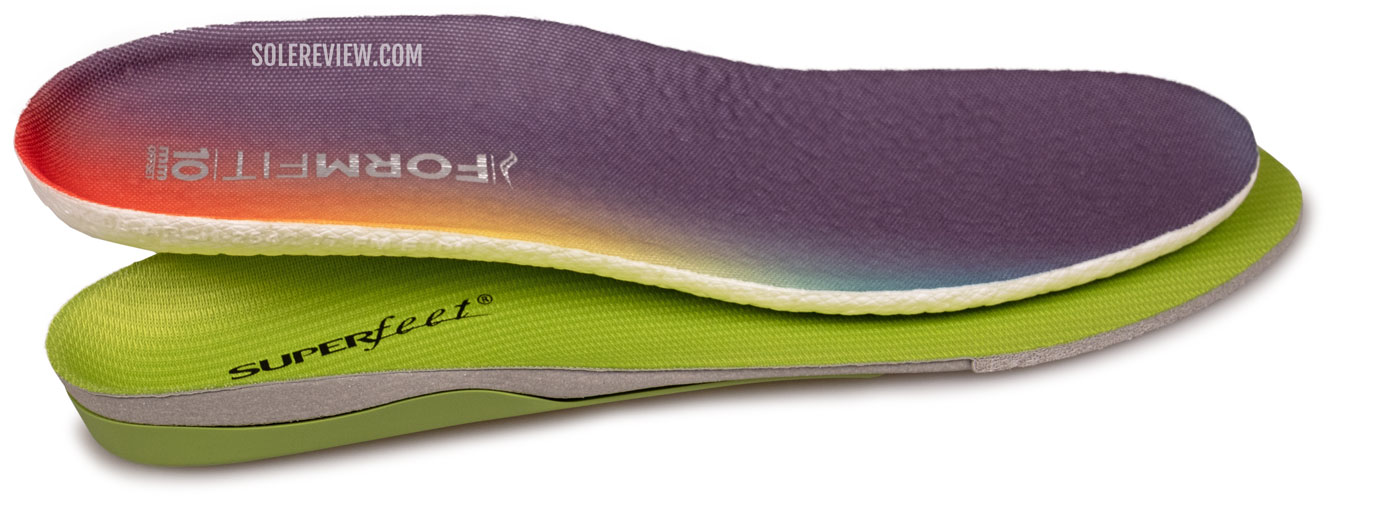
The Pwrrun+ insole can be replaced with another insole – be it a Superfeet (pictured) or custom-made orthotic.
The level of step-in softness may be affected once the Pwrrun+ insole is removed. Of course, if your orthotic is softer than the stock footbed, that’s going to affect the cushioning as well.
And if you’re a Triumph 20 owner, it’s worth pointing out that an orthotic inside the Triumph 21 could also make it relatively tighter than the 20. That’s due to the slimmer nature of the Triumph 21’s fit.
PROS AND CONS
Except for the less-than-ideal ventilation, there’s almost nothing wrong with this shoe.
The Pwrrun+ midsole is cushioned, versatile, and supportive despite its thick stack. The durable outsole grips well on most running surfaces. Except for very quick 5K races, the Triumph 21 is capable of most runs – be it everyday training or marathons.
The fully-sleeved upper is very secure, and is available in an optional wide as well.
COMPARISON: THE SAUCONY TRIUMPH 21 VERSUS SAUCONY RIDE 16
Ever since the Saucony Triumph switched to a Pwrrun+ (expanded PU foam) midsole, there’s been a healthy degree of differentiation between the Ride and Triumph.
The Triumph 21 gets its soft and responsive cushioning from the tall Pwrrun+ midsole; the Ride 16’s midsole uses a relatively low-tech EVA foam blend. Only the removable Pwrrun+ insole is shared between the two models. Otherwise, the Ride and Triumph couldn’t be more different.
The Saucony Ride 16 is firmer, an ounce lighter, and has a relatively lower midsole. It may not be as comfortable as the Triumph 21 for long runs, but it performs better as a shoe for quicker paces (4:00 min/km, 6:30 min/mile).
With only a $20 price difference separating the two, we’d rather pay $160 for the Triumph 21.
SHOES COMPARABLE TO THE SAUCONY TRIUMPH 21
If we were to narrow down the Triumph 21’s direct competitors to just three shoes, those would be the Asics Nimbus 25, Brooks Glycerin 20, and the New Balance 1080V12.
Let’s start with the Asics Nimbus 25.
Of all the shoes listed here, it has the softest ride. The new Flytefoam Blast+ midsole is incredibly cushioned, and the rocker profile also manages to add some pep. The hot upper is the only weak link on the Nimbus, but that’s a non-issue when running in cooler temperatures. Our review of the Nimbus 25 is here.
We found the New Balance 1080V12 to be a finely-tuned and versatile running shoe.
The stretch upper is extremely comfortable and conforming. The Fresh Foam midsole lacks the cushioning depth of the Nimbus or resilience of the Triumph 21, but is never found wanting in ride comfort.
And if you want a lot of stability, the Brooks Glycerin 20 is the shoe for you. The DNA flash foam midsole makes the Glycerin 20 the firmest in its class, and thus the most supportive. That makes it the best choice for heavy runners.
There are a couple of adidas shoes that use the same cushioning material (expanded Polyurethane) as the Triumph. The adidas Solarboost 5 is softer than the Triumph, yet comparable. The adidas Ultraboost Light has a stronger athleisure bent than a real running shoe, but it’s always a nice choice for low-intensity runs and casual everyday use.
Do you own this shoe? Improve this review by sharing your insights.

